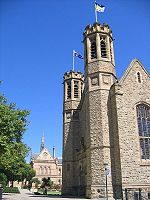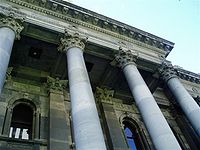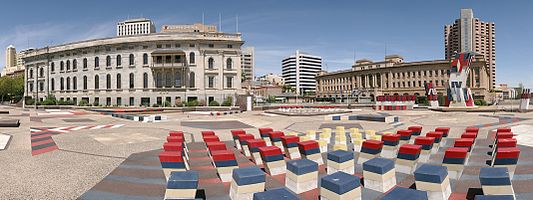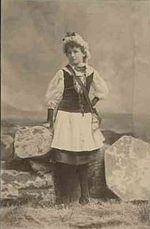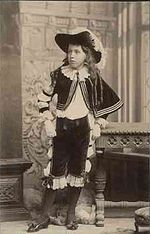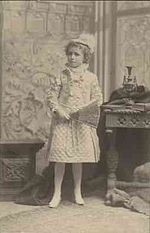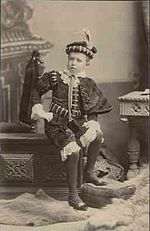- John Langdon Bonython
-
Sir Langdon Bonython
KCMG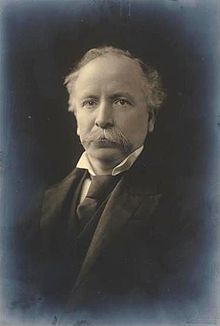
Member of the Australian Parliament
for South AustraliaIn office
30 March 1901 – 16 December 1903
Serving with Lee Batchelor, Patrick Glynn, Frederick Holder, Charles Kingston, Alexander Poynton and Vaiben SolomonMember of the Australian Parliament
for BarkerIn office
16 December 1903 – 8 November 1906Preceded by New seat Succeeded by John Livingston Personal details Born 15 October 1848
London, EnglandDied 22 October 1939 (aged 91) Nationality Cornish Australian Political party Protectionist Party Spouse(s) Mary Louisa Fredericka Balthasar Occupation Journalist - This article is about Sir John Langdon Bonython (1848-1939)
- His son was named Sir John Lavington Bonython (1875-1960)
- His grandson was named John Langdon Bonython (1905–1992)
Sir John Langdon Bonython KCMG (
 /bɒˈnaɪθən/;[1] 15 October 1848 – 22 October 1939), editor, newspaper proprietor, philanthropist, Australian politician and journalist, was a Member of the First Australian Parliament, and was editor of the Adelaide daily morning broadsheet, The Advertiser, for 35 years.[2][3]
/bɒˈnaɪθən/;[1] 15 October 1848 – 22 October 1939), editor, newspaper proprietor, philanthropist, Australian politician and journalist, was a Member of the First Australian Parliament, and was editor of the Adelaide daily morning broadsheet, The Advertiser, for 35 years.[2][3]Contents
Early life
Bonython was born in London in 1848, the second son of George Langdon Bonython (a carpenter and builder) and Annie MacBain. The family migrated to South Australia in July 1854. There, Bonython was educated at the Brougham School in North Adelaide. In 1870, he married Mary Louisa Fredericka Balthasar[2] (Marie Louise Friedrike Balthasar[3]); they had eight children of whom three daughters and three sons survived infancy.[2]
Media career
When he was sixteen, Bonython took a job at The Advertiser, where he was well regarded as a hard worker. In 1879, he became a part proprietor of The Advertiser.
In 1894, Bonython became the sole proprietor and editor of The Advertiser, positions which he held for a further 35 years. During this time, the weekly Chronicle and the evening Express newspapers were added to The Advertiser.
He retired from his newspapers in 1929, after 65 years' service.[3]
Political career
Throughout his career, Bonython had avoided local politics, but after Federation in 1901 he was nominated to represent South Australia as a Protectionist in the Australian House of Representatives at the 1901 election. He ultimately finished second in the poll and was one of seven members elected (at that time, South Australia was a single electorate with multiple members).
At the 1903 election, Bonython was elected unopposed for the newly created Division of Barker. In 1904, he was a member of the Select Committee on old-age pensions, as well as the Royal Commission on the same subject in 1905-1906.
Bonython did not stand for reelection at the 1906 election, and retired from politics.[3] In 1908 he was appointed a Companion of the Order of St Michael and St George (CMG) "In recognition of service to the Commonwealth of Australia".[4]
Public service and philanthropy
In 1883, Bonython was elected chairman of the Adelaide School Advisory Board. In 1889 he became the president of the council for the South Australian School of Mines and Industries, a position he held until his death. He often assisted the school with his own money, and provided the funds for the chemical and metallurgical laboratories there.
Bonython became chairman of the council of the agricultural college at Roseworthy in 1895, and he held this position until 1902.
He was appointed one of fourteen trustees under the soldiers' repatriation programme of 1916, and one of seven commissioners under the Australian Soldiers Repatriation Act 1917.[3] In 1919 he was appointed Knight Commander of the Order of St Michael and St George (KCMG) "In recognition of service to the Commonwealth".[5]
Bonython joined the council of the University of Adelaide in 1916, and donated over £50,000 for the construction of a hall,[6] and £20,000 to fund a Chair in law. From 1916 to 1926, Bonython was also the deputy chairman of the South Australian advisory council of education. He donated £100,000 towards the construction of Parliament House in Adelaide.[7]
- Bonython Hall
- Parliament House
Legacy
Bonython died in 1939, leaving an estate of over £4,000,000, which at the time was estimated to be one of the largest of any Australian. Beneficiaries under his will included the Pirie Street Methodist Church, where he always worshipped and of which he was a trustee; St Peter's Cathedral, to which he donated the cost of the canons' and choir stalls in 1925 in memory of his wife who had died the previous year; and the Salvation Army.
Children
On 24 December 1870 Bonython married Mary Louisa Fredericka Balthasar in Adelaide; they had eight children of whom three daughters and three sons survived infancy, and three daughters survived him.[2][3]
His children included:
- (1875-1960) Sir John Lavington Bonython who was a Lord Mayor of Adelaide.[10] (2 marriages, 6 children)
- (1877-?) Edith A. Bonython
- (?-?) Ada Bonython
Family name
Bonython was descended from an old Cornish family, well-known in Tudor and Stuart times.[3] Inspired by his grandmother, Bonython took an interest in his heritage. He had a fine library of books on Cornish history and was patron of the South Australian Cornish Association and a member of the Royal Institution of Cornwall. Although he acquired some family relics, he deeply regretted that he could not buy back Bonython Manor, the family seat in Cornwall.[2]
Bonython told The Literary Digest: "It is a Cornish name and the accent is on the second syllable: Bon-y'thon, y as in spy. The ancient family located at Bonython in the Lizard district at a very early period. Existing deeds show that Stephen Bonython was in possession of the family lands in 1277."[1]
Honours
Bonython was knighted in 1898. In 1908 he was made a Commander of the Order of St Michael and St George (CMG), and in 1919 was promoted to Knight Commander of that Order (KCMG).
In 1935, Bonython was made the first Australian bard of the Cornish Gorseth Kernow.[13]
The Division of Bonython, an Australian Electoral Division in the northern suburbs of Adelaide, was named after Bonython. It was created in 1955 and abolished in 2004.[3]
See also
- Members of the Australian House of Representatives, 1901-1903
- Members of the Australian House of Representatives, 1903-1906
- Bonython
References and notes
- ^ a b Charles Earle Funk, What's the Name, Please? (Funk & Wagnalls, 1936).
- ^ a b c d e W. B. Pitcher, Bonython, Sir John Langdon (1848 - 1939), Australian Dictionary of Biography, Volume 7, Melbourne University Press, 1979, pp 339-341
- ^ a b c d e f g h Serle, Percival (1949). "Bonython, John Langdon". Dictionary of Australian Biography. Sydney: Angus and Robertson. http://gutenberg.net.au/dictbiog/0-dict-biogBe-Bo.html#bonython1. Retrieved 2008-11-19.
- ^ Companion of the Order of St Michael and St George 9 November 1908 Citation: In recognition of service to the Commonwealth of Australia
- ^ KCMG 3 June 1919 Citation: In recognition of service to the Commonwealth
- ^ "Bonython Hall" is the Great Hall of the University of Adelaide. It is located on North Terrace, Adelaide opposite Pulteney Street.
- ^ Parliament House is located on the corner of North Terrace and King William Street, Adelaide.
- ^ a b On 18 April 1900 in the Pirie Street Methodist Church, Mary Elsie Bonython married Sir Herbert Angas Parsons (1872-1945), judge and politician. "Parsons spent many hours at the Adelaide Club, preferring its convivial atmosphere to his wife's Methodism". "Survived by Lady Parsons and their two sons, he died of cirrhosis of the liver". (Kwan, Australian Dictionary of Biography, vol.11 pp.148-150.)
- ^ a b Elizabeth Kwan, Parsons, Sir Herbert Angas (1872 - 1945), Australian Dictionary of Biography, Volume 11, Melbourne University Press, 1988, pp 148-150.
- ^ W. B. Pitcher, Bonython, Sir John Lavington (1875 - 1960), Australian Dictionary of Biography, Volume 7, Melbourne University Press, 1979, pp 341-342.
- ^ Funeral notices The Advertiser (Adelaide, SA) 15 February 1915 pg.2
- ^ Death of Mr. Hugh Bonython Barrier Miner (Broken Hill, NSW) 10 March 1915 p.4
- ^ Dunkerley Family Web Pages – The Bards of the Gorseth of Cornwall in Australia
Parliament of Australia New division Member for South Australia
1901–1903
Served alongside: Batchelor, Glynn, Holder, Kingston, Poynton, SolomonDivision abolished New division Member for Barker
1903–1906Succeeded by
John LivingstonCategories:- 1848 births
- 1939 deaths
- Australian federationists
- Australian journalists
- Cornish Methodists
- Knights Commander of the Order of St Michael and St George
- Australian knights
- Members of the Australian House of Representatives
- Members of the Australian House of Representatives for Barker
- Australian people of Cornish descent
- Bards of the Cornish Gorseth
- Protectionist Party politicians
- People from Adelaide
- Jubilee 150 Walkway
- Bonython family
Wikimedia Foundation. 2010.



